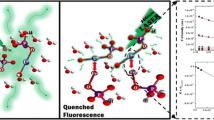Abstract
A fluorescence based method has been developed for the determination of trace amounts of uranium in thorium matrix using a mixture of phosphoric acid (H3PO4) and sulfuric acid (H2SO4), as fluorescence enhancing reagent for uranyl (UO2 2+) ion fluorescence. Synthetic samples mimicking the composition of ThO2 fuel were prepared and the concentration of U(VI) was estimated. Satisfactory results are obtained when uranium is present at a concentration of 10 ppm in solid thorium samples with good precision.





Similar content being viewed by others
References
IAEA-TECDOC-1450 (2005) Thorium fuel cycle—potential benefits and challenges. IAEA, Vienna
Gambogi J (2013) U.S. Geological survey, mineral commodity summaries, pp 168–169
Sinha RK, Kakodkar A (2006) Design and development of the AHWR—the Indian thorium fuelled innovative nuclear reactor. Nuc Eng Des 236:683–700
Sujoy Biswas, Pathak PN, Roy SB (2012) Development of an extractive spectrophotometric method for estimation of uranium in ore leach solutions using 2-ethylhexyl phosphonic acid-mono-2-ethylhexyl ester (PC88A) and tri-n-octyl phosphine oxide (TOPO) mixture as extractant and 2-(5-bromo-2- pyridylozo)-5-diethyl aminophenol (Br-PADAP) as chromophore. Spectrochim Acta Part A 91:222–227
Orabi AH (2013) Determination of uranium after separation using solvent extraction from slightly nitric acid solution and spectrophotometric detection. J Radiat Res Appl Sci 6:1–10
Loïc Jauberty, Nicolas Drogat, Jean-Louis Decossas, Vincent Delpech, Vincent Gloaguen, Vincent Sol (2013) Optimization of arsenazo-III method for the determination of uranium in water and plants samples. Talanta 115:751–754
Sundar U, Ramamurthy V, Buche V, Rao Narasinga D, Sivadasan PC, Yadav RB (2007) Rapid measurements of concentrations of natural uranium in process stream samples via gamma spectrometry at an extraction facility. Talanta 73:476–482
Dresslera Valderi L, Dirce Pozebonb, Curtius Adilson J (2001) Determination of Ag, Te, U and Au in waters and in biological samples by FI-ICP-MS following on-line preconcentration. Anal Chim Acta 438:235–244
Agrawal YK, Shah G, Vora SB (2006) Solvent extraction, speciation, separation and recovery of uranium(VI) from nuclear fuel, phosphate rocks and monazite sand with N-phenylbenzo-18-crown-6- hydroxamic acid. J Radioanal Nucl Chem 270:453–459
Chuanmin Ruan, Wensui Luo, Wei Wang, Baohua Gu (2007) Surface-enhanced Raman spectroscopy for uranium detection and analysis in environmental samples. Anal Chim Acta 605:80–86
Abdulla W, Al-Shawi Roger Dahl (1995) Determination of thorium and uranium in nitrophosphate fertilizer solution by ion chromatography. J Chromatography A 706:175–181
Sarkar A, Alamelu D, Aggarwal SK (2009) Laser-induced breakdown spectroscopy for determination of uranium in thorium-uranium mixed oxide fuel materials. Talanta 78:800–804
Suresh A, Patre Dinesh K, Srinivasan TG, Vasudeva Rao PR (2002) A new procedure for the spectrophotometric determination of uranium(VI) in the presence of a large excess of thorium(IV). Spectrochimica Acta A 58:341–347
Moulin C, Decambox P, Trecani L (1996) Direct and fast uranium determination in zirconium by time-resolved laser-induced fluorescence spectrometry. Anal Chim Acta 321:121–126
Meinrath G, Kato Y, Yoshida Z (1993) Spectroscopic study of the uranyl hydrolysis species (UO2)2(OH) 2+2 . J Radioanal Nucl Chem 174:299–314
Sarkar A, Alamelu D, Aggarwal SK (2009) Determination of trace constituents in thoria by laser induced breakdown spectrometry. J Nucl Materials 384:158–162
Lakowicz JR (2006) Principles of Fluorescence Spectroscopy, 3rd edn. Springer, New York
Hieftje GM, Haugen GR (1981) Correction of quenching errors in analytical fluorimetry through use of time resolution. Anal Chim Acta 123:255–261
Maji S, Sundararajan K, Viswanathan KS (2000) Correction for quenching in fluorimetric determinations using steady state fluorescence. Spectrochimica Acta A 56:1251–1256
Author information
Authors and Affiliations
Corresponding author
Rights and permissions
About this article
Cite this article
Maji, S., Kumar, S. & Sankaran, K. Fluorimetric estimation of U(VI) in the presence of a large excess of Th(IV). J Radioanal Nucl Chem 302, 1277–1281 (2014). https://doi.org/10.1007/s10967-014-3527-x
Received:
Published:
Issue Date:
DOI: https://doi.org/10.1007/s10967-014-3527-x




